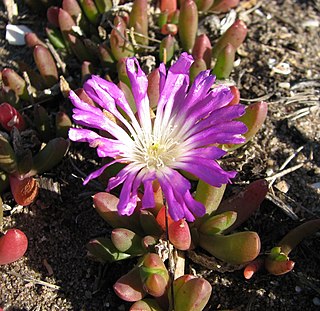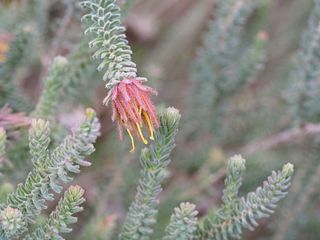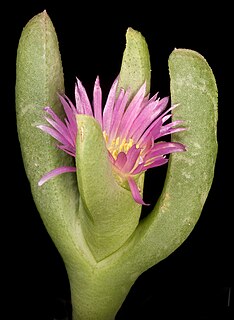
Carpobrotus virescens, commonly known as coastal pigface, is a prostrate coastal succulent shrub of the family Aizoaceae native to Western Australia. The Noongar peoples know the plant as Kolbogo or Metjarak.

Disphyma is a genus of flowering plants in the family Aizoaceae that are native to New Zealand, Australia and southern Africa. Plants in this genus are prostrate, annual or short-lived perennial shrubs with succulent leaves and daisy-like flowers arranged singly on the ends of shoots with petal-like staminodes, many stamens and usually five styles.

Verticordia staminosa is a flowering plant in the myrtle family, Myrtaceae and is endemic to the south-west of Western Australia. It is a shrub comprising two subspecies, one of which has two varieties. All three types have a limited distribution and have been classified as "Threatened". It is distinguished from other species of verticordia by its prominent, long stamens which extend well beyond its feathery yellow sepals and petals.

Hibbertia hypericoides, commonly known as yellow buttercups, is a species of flowering plant in the family Dilleniaceae and is endemic to the south-west of Western Australia. It is usually a spreading shrub with linear to elliptic or egg-shaped leaves, and yellow flowers, usually with ten to fifteen stamens arranged in a cluster on one side of the two densely hairy carpels.

Conothamnus is a genus of flowering plants in the family Myrtaceae and is endemic to the south-west of Western Australia. They are woody shrubs similar to melaleucas but differ in that their leaves are usually arranged in opposite pairs and the maximum number of seeds per fruit is three.
Verticordia dasystylis is a flowering plant in the myrtle family, Myrtaceae and is endemic to the south-west of Western Australia. It is a small shrub, with many stems at its base, oblong leaves and scented, fluffy, yellow and white flowers. There are three subspecies, each of which has a priority conservation status.

Darwinia chapmaniana, commonly known as Chapman's bell or Eganu bell, is a plant in the myrtle family Myrtaceae, and is endemic to the south-west of Western Australia. It is a low, rounded, spreading shrub with greyish, hairy leaves and flowers in heads of about 14 small, tubular flowers. The heads are surrounded by long, reddish-yellow, hairy bracts.

Gunniopsis papillata, commonly known as the twin-leaved pigface, is a species of succulent plant in the iceplant family, Aizoaceae and is endemic to inland areas of Australia. It is an annual herb with pimply, spatula-shaped to egg-shaped leaves and flowers with white or yellow petals.
Thryptomene elliottii is a species of flowering plant in the family Myrtaceae and is endemic to southern central Australia. It is a shrub with decussate, egg-shaped to club-shaped leaves and pink or white flowers with five petals and five stamens.
Thryptomene nitida is a species of flowering plant in the family Myrtaceae and is endemic to a small area in the south-west of Western Australia. It is a spreading shrub with upward-pointing, egg-shaped leaves with the narrower end towards the base, and flowers with five pale purple or pinkish petals and ten stamens.
Vlokia ater was the first species described for the genus Vlokia in the Aizoaceae plant family. The genus name honors the discoverer, South African botanist, Jan H. J. Vlok (1957-). The species name derives from the Latin adjective "ater" for "black" and refers to the black coloring which older leaf leaves assume.
Drosanthemum quadratum is a succulent plant in the ice plant family, Aizoaceae, indigenous to the Overberg region of the Western Cape Province, South Africa.

Asterolasia nivea, commonly known as Bindoon starbush, is a species of weak sub-shrub that is endemic to the southwest of Western Australia. It has leathery oblong to narrow elliptical leaves and white flowers arranged in groups of about three flowers with thick-centred, shield like, star-shaped hairs on the back of the petals.

Sarcozona, commonly known as pigfaces, is a genus of two species of flowering plants in the family Aizoaceae, both species endemic to Australia. They are small, erect or low-lying, succulent perennials with leaves that are triangular in cross-section and arranged in opposite pairs, and daisy-like flowers with twenty to eighty petal-like staminodes and up to 150 stamens.

Sarcozona praecox, commonly known as sarcozona, is species of flowering plant in the family Aizoaceae and is endemic to Australia. It is a small erect to low-lying, succulent shrub with leaves that are triangular in cross-section and arranged in opposite pairs, and daisy-like flowers with twenty to eighty pink, petal-like staminodes and 20 to 150 stamens.
Hibbertia cockertoniana is a species of flowering plant in the family Dilleniaceae and is endemic to the south-west of Western Australia. It is an erect shrub with scattered linear leaves and yellow flowers arranged singly in leaf axils usually with ten stamens all on one side of the two carpels.
Hibbertia hooglandii is a species of flowering plant in the family Dilleniaceae and is endemic to the Kimberley region of Western Australia. It is a small, erect or spreading, multi-stemmed shrub with linear leaves and golden yellow flowers arranged singly in leaf axils, with seventeen to twenty-five stamens, all on one side of two densely hairy carpels.

Hibbertia polystachya is a species of flowering plant in the family Dilleniaceae and is endemic to the south-west of Western Australia. It is an erect to sprawling or straggly shrub with narrow elliptic to linear leaves and yellow flowers arranged in groups of up to five with about ten stamens and a similar number of staminodes, arranged on one side of two hairy carpels.

Hibbertia porongurupensis is a species of flowering plant in the family Dilleniaceae and is endemic to a restricted area of the south-west of Western Australia. It is a glabrous shrub with broadly elliptic to more or less round leaves and yellow flowers arranged singly in leaf axils with large numbers of stamens arranged around five carpels.
Hibbertia squarrosa is a species of flowering plant in the family Dilleniaceae and is endemic to the west of Western Australia. It is an erect shrub with linear leaves and yellow flowers with twenty stamens arranged around five glabrous carpels.












